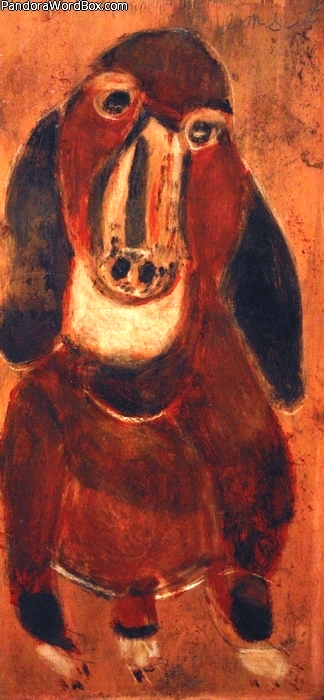Our websites offer information mostly for educational purposes with no intent to alter health care protocols nor to serve as a sole source of medical information.
Always seek the advice of your local health care provider.
|
×  Get the Point! PAIN – WOMAN – UKRAINE – PUTIN MOTHER – SISTER – SPOUSE – MOTHER RUSSIAN WAR – HOLOCAUST – GENOCIDE |
DAUCHSHUND - CHONDRO-OSTEO DYSPLASIA

"Badger Dog Dachshund " (see related A), 1910 Jimmy Lee Sudduth Montgomery Museum of Art, Montgomery, Alabama, USA
Badger dogs (Dachs in German) or Dashing Dachshunds are perhaps so called because of their instinct to dart and instantly withdraw their snout from a hand of a stranger as if to avoid the bite of a badger or another creature. Dachshunds are the product of intensive reproductive inbreeding and their appearance (phenotype) and behavior are the result - they elucidate strong attachments by their loving affection to a single or few persons (not much interest in children), their high intelligence (correspondingly they are "stubborn" or hard to train) and resistance to obey mindless impositions. They have a penchant to dash after small rodents including squirrels as well as almost to demand to sleep under the covers of their principal human companion. The price? hard and slow "potty" training ... why to "go" outside where it may be cold and raining ... there are alternative spots in the house ... the house smells anyhow ... so goes the logic of a dachshund ...
In medical terms, Dachshunds represent a chondro-osteo-dysplasia or rather a dysplasia of the connective tissue resulting in hyper-elastic skin and joints, a rather longer vertebral column and severely shortened limbs. Some similarities with human "Achondroplasia" - however in humans, the skull and facial bones are also affected. Both achondroplastic humans and dachshunds have a propensity to become obese and with aging to suffer from painful spinal degenerative complications.
We also like to honor Jimmy Lee Sudduth who painted this work. He represents in our view, a marvelous emblem of redemption through art. His parents were African-American rural "hands" on a farm at Caines Ridge, near Fayette, Alabama. The extreme poverty and racist realities then, did not stunt the young Jimmy - quest to express his spirit drove him to carve wooden dolls and to draw on shards of plywood, doors or boards from demolished buildings. He painted by mixing shades of Alabama red-clay and other earthy pigments, motor oil, and discarded paint - as binders he used what he could - sugar and coffee, among others. It was not until he was 58 years old that then he became a featured artist in Alabama. Thereafter he was "discovered" by the Smithsonian Institutions, museums and commercial media. As a genius and prodigy he stands as a pillar of "outsider art" and of "Southern self-taught art" - he is also remembered as an outstanding musician and exponent of "blues".
20220609 ww
|






